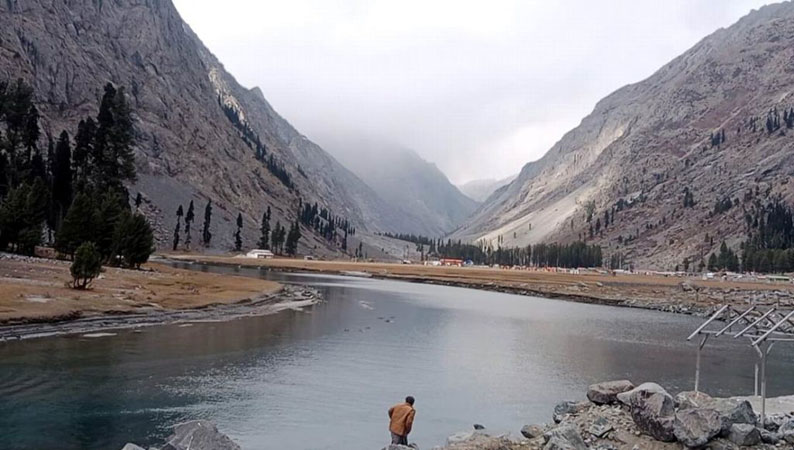 As the winter season blankets the majestic Kalam valleys in a layer of snow, the region has become a hotspot for eco-tourism, drawing an influx of visitors from the plains of Khyber Pakhtunkhwa on Sunday.
As the winter season blankets the majestic Kalam valleys in a layer of snow, the region has become a hotspot for eco-tourism, drawing an influx of visitors from the plains of Khyber Pakhtunkhwa on Sunday.
Tourists, alongwith their families, flock to this serene paradise, seeking respite from the hustle and bustle of city life, indulging in local delicacies, and immersing themselves in the breathtaking natural beauty of the area amid moonlight serenity.
The weekend saw the local hotels brimming with tourists, as families gathered to enjoy the crisp winter air, the scent of deodar trees, and the melodic chirping of birds perched in lush green forests. One of the region’s most celebrated culinary offerings, Chappli Kabab, a rich, spiced meat patty, has become a favorite for eco-tourists, alongside the famed trout fish.
Many tourists, like Haseeb Khan from Peshawar, are drawn to Kalam not only for its pristine beauty but also for these flavorful, locally-sourced spicy dishes.
“The weather in Kalam is amazing. We have had a wonderful time amidst this beautiful setting, filled with great fun and excitement and will come again for snowfall.”
As Kalam is transformed into a winter wonderland, visitors find themselves entranced by the ethereal beauty of Mahodand Lake, nestled at an altitude of 9,400 feet. This pristine body of water, with its striking bluish-white hue, serves as a backdrop for tourists seeking tranquility and outdoor adventure.
A leisurely boating trip across the lake’s chilly waters is a popular activity, offering visitors an immersive experience amidst nature’s grandeur.
“I came to Kalam with my family after three years to enjoy its mesmerizing natural beauty and cold weather on the weekend,” said Lecturer Naveed Khan, a resident of Nowshera while talking to APP. Every sun rays add to the winter magic, enhancing the lush greenery and the lake’s emerald allure,” he said, adding Mahodand lake is renowned not just for its stunning vistas but also for its freezing waters and abundant trout fish besides exploring it through boating of Rs 200 trip.” The enhanced infrastructure and Swat motorway have made it easier for tourists to indulge in various adventure sports in Upper Swat, further elevating the lake’s appeal.
“Mahodand lake stands as a testament to nature’s splendor. It invites all to experience its ethereal beauty, to breathe in the fresh, rain-kissed air, and to create unforgettable memories in one of Pakistan’s most enchanting locales,” he said.
Saad Khan, the spokesman of Tourism and Culture Authority told APP that elaborate arrangements were made for accommodation and facilitation of tourists and adventure sports lovers during winter season in Khyber Pakthunkhwa. Under Development of Ecotourism Project (ETP), he said that camping pods with facilities of two to four beds alongwith wash washrooms and kitchen were established at various scenic places including Malakand and Hazara divisions. Besides establishment of camping pod at Gabeen Jabba near Mahudhand lake and Sharan near Saiful Malook lake, he said 10 more camping pods were installed at different tourism places to provide affordable accommodations to tourists’ families. These camping pods were established at Sharan Kaghan Mansehra, Mahaband Buner-Swabi, Allai Batagram, Bamburait Chitral, Tandyani Abbottabad, Bisigram Swat, Yakhtangi Shangla, Saheed e Sir and Malka Swat and Sheikh Badin in DI Khan.
Bishigram, Shran, Yakhtangi, Shaheed e Sir and Malk camping pods have already been opened for tourists.
Each pod has two to four beds for families, a wash room and a small kitchen with foolproof security arrangements by tourism police, he said, adding Rs3500 to Rs5000 per day/night stay was being charged against Rs12,000 to Rs15,000 per room by a private hotels at Khagan, Naran and Galiyat valleys.
As many as 10 more camping pods at Jargo and Sulatanr in Swat, Lashkargha Broghal Valley and Surlaspur Shandor valley Upper Chitral, Kumrat velley in Upper Dir, Laram Top and Shahi Bin Shahi in Lower Dir, Lilowani Alpuri in Shangla Samanah Top in Orakzai/Hangu and Kalam Swat.
One of the key initiatives that have been undertaken is to increase the presence of security personnel in tourist spots. This has made tourists feel safer and more secure, resulting in an increase in the number of tourists during winter.
Tourism police force comprises well-trained officers equipped to handle any situation that may arise while tourists are visiting Swat to enjoy snowfall along with trout and Chappli Kabab. These officers are fluent in several languages, including English, to make communication with foreign tourists easier.
A mobile application called the “Tourist Safety App,” has been launched enabling tourists to quickly and easily contact the tourist police in case of an emergency.
Furthermore, the government has invested heavily in improving the infrastructure, including the road network, transportation, and accommodation facilities.
The construction of new hotels, resorts, and rest houses has made it easier for tourists to find suitable accommodations while enhanced road networks had reduced load on the established tourism stations.
Muhammad Ali Syed, General Manager, Tourism and Culture Authority said that waterfalls of Lamchar, Sajkot, Noori, Chajjian Haripur, Jarogo Swat, Lanchar Dir and Umbrella Abbottabad were being developed to promote ecotourism.
Tourism spots, jeep tracks and roads to link waterfalls of Abbottabad, Haripure and Mansehra were being developed.
To reduce tourists’ load at Galiyat, Kaghan, Naran, Kalam, Malam Jabba and Dir, jeepable tracks was being constructed in 15 areas with an estimated cost of Rs500 million, adding camping pods were also established near it while local communities were encouraged to reserved at least one rooms for tourists to bolster income of rural population.
This post was originally published on here







